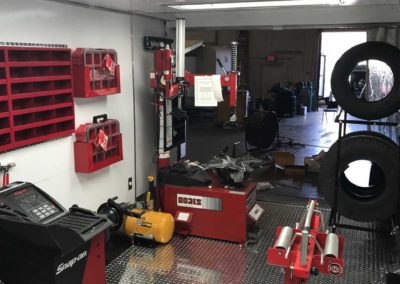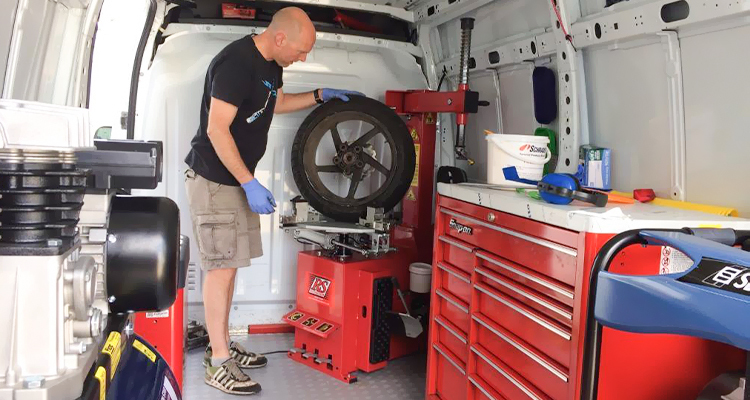Emergency Situation Mobile Tire Service Available in Las Vegas
Emergency Situation Mobile Tire Service Available in Las Vegas
Blog Article
Tire Solution: Proven Methods for Ideal Tire Upkeep and Care
Preserving optimum tire condition is paramount for both safety and security and performance of any lorry. From making certain correct tire pressure to routine rotation and alignment, there are tried and tested techniques that can significantly prolong the life-span of your tires and enhance total driving experience. As we explore the ins and outs of tire care and upkeep, we will certainly uncover crucial standards that every automobile proprietor need to abide by for the best feasible results. Allow's dig into the world of tire solution and uncover the secrets to keeping your tires in excellent form for the lengthy haul.
Importance of Tire Pressure
Correct tire pressure is a critical consider guaranteeing optimum lorry efficiency and safety when traveling. Preserving the recommended tire pressure degrees given by the supplier supplies countless benefits. Appropriate tire stress promotes much better gas performance, as under-inflated tires can lead to raised rolling resistance, causing the engine to work harder and eat even more gas. Second of all, correct tire stress makes sure also step wear, enhancing tire durability and saving money in the future by delaying the need for premature substitutes. Additionally, properly blew up tires contribute to boosted handling and stopping abilities, important for risk-free driving in numerous road problems. Over-inflated tires, on the other hand, can result in lowered traction and a harsher experience. Conversely, under-inflated tires are prone to overheating, which can bring about crashes and blowouts. Frequently examining and readjusting tire pressure, specifically previously lengthy trips, is a basic yet effective means to improve lorry efficiency, extend tire life-span, and focus on safety when driving.
Tire Turning Standards
When considering tire rotation guidelines, it is crucial to understand the importance of this upkeep job in making best use of tire lifespan and keeping optimal vehicle efficiency. Tire turning involves transforming the placement of each tire on a lorry to ensure also step wear. Front tires have a tendency to put on extra swiftly than back tires due to guiding pressures, making regular turning important for well balanced wear patterns.

Advantages of Wheel Positioning
Ensuring correct wheel placement after tire rotation is important for maintaining well balanced wear patterns and optimizing car efficiency. Wheel alignment refers to the modification of the angles of the wheels to the maker's specifications. One of the vital advantages of wheel placement is boosted steering and handling action. When the wheels are effectively aligned, it minimizes steering initiative, guaranteeing a smoother and much more controlled driving experience. In addition, appropriate wheel placement assists to expand the life expectancy of your tires. Misaligned wheels can create uneven tire wear, leading read what he said to early tire substitute and enhanced maintenance prices.

Tire Footstep Deepness Inspect
Carrying out a normal examination of tire tread deepness is crucial for maintaining risk-free driving problems and lengthening the life-span of your tires. The walk on your tires plays a crucial duty in providing traction, specifically in slippery or damp conditions. To examine your tire walk deepness, you can use a step deepness scale or the dime examination. The recommended tread depth is at least 2/32 of an inch. If the walk deepness is listed below this limit, it is time to replace your tires to ensure optimal efficiency and security when driving. Uneven step wear can indicate issues with tire placement, pressure, or suspension, highlighting the importance of regular tread deepness checks. Overlooking to monitor and preserve proper walk deepness can cause lowered grasp, longer stopping distances, and a boosted risk of hydroplaning. By integrating tire tread depth explore your regular upkeep routine, you can drive with here self-confidence recognizing that your tires are in leading problem.
Seasonal Tire Evaluation
Seasonal tire evaluation is a fundamental facet of tire upkeep that makes certain tires are prepared to encounter the difficulties posed by different climate problems. In prep work for wintertime, it is essential to examine the tire pressure regularly as cool temperatures can trigger tire pressure to drop. By performing regular seasonal tire evaluations, vehicle drivers can prolong tire life-span, boost fuel efficiency, and most significantly, ensure a protected driving experience in varying weather condition problems.
Verdict
To conclude, maintaining appropriate tire stress, revolving tires on a regular basis, straightening wheels properly, keeping an eye on step deepness, and conducting seasonal inspections are essential practices for optimal tire treatment. By adhering to these proven methods, chauffeurs can ensure their tires last much longer, do better, and add to general car safety. It is very important to focus on tire upkeep to prevent mishaps, enhance fuel performance, and prolong the life-span of tires.
Adequate tire pressure promotes much better gas efficiency, as under-inflated tires can lead to boosted rolling resistance, triggering the engine to work more challenging and take in more fuel.When thinking about tire turning guidelines, it is crucial to recognize the importance of this upkeep job in taking full advantage of tire life-span and maintaining ideal automobile performance. Seasonal tire inspection is a fundamental aspect of tire upkeep that ensures tires are prepared to encounter the challenges presented by various weather problems. By conducting routine seasonal tire evaluations, chauffeurs can extend tire life-span, improve fuel performance, and most importantly, ensure a safe driving experience in differing weather condition problems.
In verdict, maintaining proper tire stress, revolving tires consistently, lining up wheels appropriately, keeping an eye on step deepness, and conducting seasonal assessments are crucial methods for ideal tire care.
Report this page